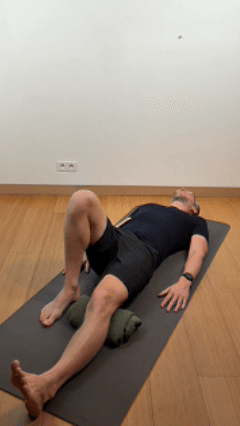Patellar Tendinitis in Triathletes - How to Manage It and Come Back Stronger?

Pierre
2/2/2025

Patellar Tendinitis in Triathletes - How to Manage It and Come Back Stronger?
Have you ever felt persistent pain at the front of your knee after an intense training session?
If so, you might be dealing with patellar tendinitis, also known as jumper’s knee or patellar tendinopathy.
This persistent knee pain can quickly disrupt your training and performance, but don’t panic! This article will help you explore the causes of this injury, provide the best strategies to prevent it, and guide you step by step through treatments to eliminate it once and for all so you can regain your performance level.
What is Patellar Tendinitis?
Patellar tendinitis is an overuse injury that affects the patellar tendon, located just below the kneecap (patella). This tendon connects the patella to the tibia and plays a key role in transmitting force from your quadriceps, allowing you to extend your leg—whether for running, cycling, or even kicking while swimming.
For triathletes, repetitive movements and high loads on the knee from running and cycling can lead to microtears in the tendon fibers. If these microtears are not treated, they can result in tendon degeneration.
Symptoms of Patellar Tendinitis
The key signs of patellar tendinitis include:
- Pain at the front of the knee, just below the kneecap, especially during activities involving jumping, running, or squatting.
- Increased pain with specific movements, such as climbing stairs or running downhill.
- Morning stiffness and discomfort, which improve with gradual warm-up.
- Localized pain, when pressing on the patellar tendon or during movements that heavily engage the tendon.
- Pain after prolonged sitting, such as during a car ride or at the movies, where the knee remains bent.
- Reduced athletic performance, due to persistent discomfort and decreased range of motion.
If you experience these symptoms, it’s time to take action and follow the steps below for an effective recovery.
Main Causes of Patellar Tendinitis
The factors contributing to patellar tendinopathy are often multiple, including:
- Overtraining: A sudden increase in volume or intensity can overload the tendon.
- Muscle imbalances: Weakness in the quadriceps or hamstrings can put extra stress on the tendon.
- Lack of flexibility: Tight muscles in the quadriceps and calves increase tension on the tendon.
- Poor biomechanics: Bad posture or alignment issues (flat feet, knock knees) can exacerbate knee stress.
How to Treat Patellar Tendinitis in Triathletes
With proper treatment and patience, full recovery is possible. Here are the key steps to overcoming this condition.
1. Reduce Inflammation and Initial Load
When dealing with inflammation, it’s crucial to act quickly to prevent the problem from worsening. During this phase, it’s best to reduce stress on your knee.
What Should You Do?
- Active rest: No need to stop exercising completely, but reduce and adjust your training volume and intensity. If your pain is above 3/10 and still present 24 hours after your workout, your session was too intense. Swimming remains a great alternative to maintain fitness without worsening the problem.
- Ice therapy: Apply ice to the painful area for 15 minutes, 3 to 4 times a day.
- Gentle stretching: Stretch your quadriceps and hamstrings to reduce tension on the patellar tendon.
- Taping or bracing: Supportive taping can help reduce pain during activities.
Example Stretch:
Stand and grab your right ankle with your right hand, gently pulling your foot towards your glutes while keeping your back straight. Hold for 20 to 30 seconds, then switch legs.

With these initial measures, you should feel pain relief within a few days. Now, let's move on to rehabilitation.
2. Progressive Strengthening and Specific Exercises
Progressive muscle strengthening is essential for treating patellar tendinopathy. Even if the pain disappears, it’s crucial to follow this step to ensure full recovery. Here are some specific exercises, inspired by validated protocols and used in the SupaTriathlete app:
Step 1: Isometric Strengthening
Isometric exercises reduce pain and strengthen the tendon.
- Isometric Knee Extension:
Lie down with your leg extended in front of you. Gently press your heel into the ground to contract your quadriceps without moving the leg. Hold for 30 to 45 seconds. Repeat 3 to 5 times.

Step 2: Eccentric Strengthening
Eccentric exercises help repair the tendon.
- Single-Leg Decline Squat:
Stand on a step, slowly lower yourself by bending one knee to about 120°, then return to the starting position using both legs. Perform 3 sets of 10 reps, 3 times per week.

3. Returning to Training
After 6 to 12 weeks of treatment, you can gradually resume running and cycling.
Increase intensity and distance gradually, and be attentive to any recurrence of pain.
Preventing Patellar Tendinitis
To avoid recurrence or prevent this injury from happening:
- Regularly strengthen your muscles: Include quadriceps, hamstrings, and glute exercises in your weekly routine.
- Stretch your muscles: Maintain good flexibility in the quadriceps, hamstrings, and calves.
- Optimize your technique: Improve your running stride and bike positioning with a specialized coach.
- Take care of your equipment: Invest in shoes suited to your body mechanics and ensure your bike setup is correct.
- Progress gradually: Don’t increase training volume or intensity too quickly—follow a steady progression of no more than 10% per week.
- Warm-up and recovery: Never neglect these steps to prepare your body and allow it to recover.
I personally experienced "patellar tendinitis" in both knees at the same time... At the time, even 5 minutes of low-intensity activity was unbearable—I finished those sessions in tears due to the intense pain. But rest assured, by following the recommendations outlined in this article, I was able to progressively return to training in just a few weeks.
Conclusion: With Patience, Recovery is Within Reach!
Patellar tendonitis may seem like a frustrating obstacle, but with the right management and a progressive approach, you'll be able to recover your level of performance and continue to excel in triathlon.
Want to Go Further?
Looking to enhance your triathlon practice by optimizing your physical preparation, nutrition, and mental management? Enjoy a free 7-day trial on SupaTriathlete: Click here to start!
Take care of your knees, because a healthy triathlete is a performing triathlete. 🏊♂️🚴♂️🏃♂️
For all you need to know about triathlete injuries, take a look at The Encyclopedia of Injuries for Triathletes - Understand, Prevent, and Heal.
Join a Community of Like-Minded Triathletes
What if you could be part of a platform designed by and for triathletes?
Because triathlon isn’t just about combining three sports...
I’m building a platform to meet the real needs of triathletes, whether beginner or experienced. The goal is simple: to help you progress with tools and features that make your life easier. But for that, I need your input!
👉 Join the waiting list for free, gain access to our platform, and help us build it based on your needs. You’ll be able to request the features you really need and have your voice heard. Together, we’ll create THE platform every triathlete has been waiting for.
💻 Click here to sign up for free and share your ideas
See you on the other side? Can’t wait to hear your ideas! 🚀